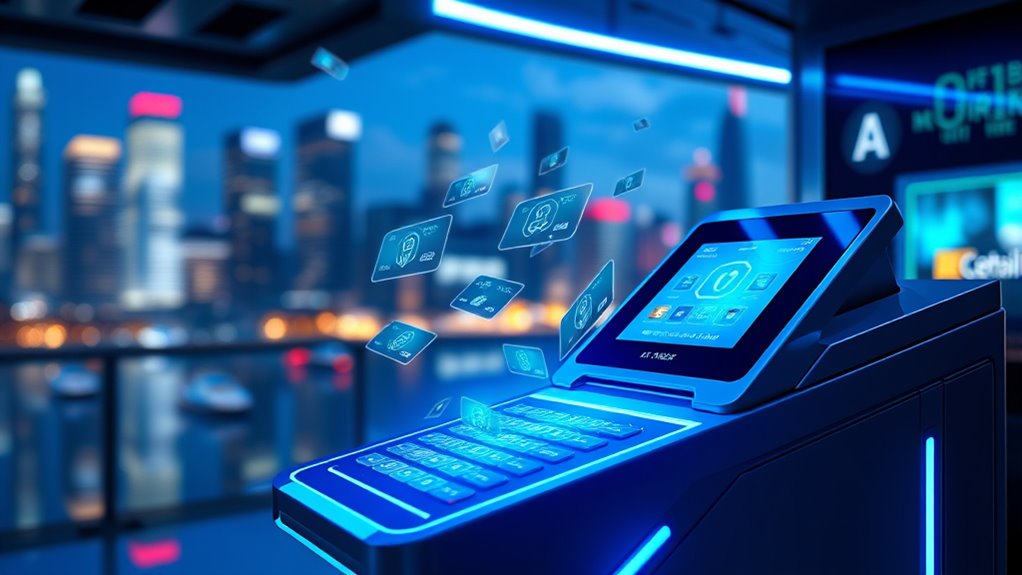The future of card-not-present transactions with AI promises faster, more secure, and frictionless payments. Biometric authentication will replace passwords, making checkout quicker and safer, while real-time fraud detection actively prevents unauthorized transactions. These AI-driven systems quickly adapt to emerging cyber threats, boosting trust and reducing fraud risks. As these innovations evolve, your online shopping experience will become more seamless and secure—if you keep exploring, you’ll see how these technologies are shaping the way we pay.
Key Takeaways
- AI-driven biometric authentication will enable faster, seamless verification, reducing reliance on passwords in card-not-present transactions.
- Real-time AI fraud detection systems will identify and prevent suspicious activities instantly, enhancing transaction security.
- Continuous AI learning will adapt to emerging cyber threats, providing increasingly robust protection for online payments.
- Enhanced user experiences will minimize cart abandonment and friction through secure, quick authentication methods.
- Broader integration of AI in digital security will create a more secure, frictionless ecosystem for future card-not-present transactions.

As digital payments continue to grow, AI is transforming how we handle card-not-present transactions. You no longer need to worry about the physical card or manual verification processes slowing down your purchases. Instead, AI-driven systems are enabling seamless, secure ways to confirm your identity, and biometric authentication plays an essential role here. Using fingerprints, facial recognition, or voice commands, these technologies verify that you are who you claim to be without the need for passwords or PINs. This not only speeds up your checkout experience but also considerably reduces fraud risks that come with remote transactions.
Fraud detection systems powered by AI are becoming smarter and more adaptive, allowing them to identify suspicious activities in real time. These systems analyze a multitude of data points—such as transaction patterns, device information, and location—to flag anomalies that may indicate fraud. If something seems off, the system can automatically block the transaction or prompt additional verification, protecting you from unauthorized charges. Because AI learns from every transaction, it continuously improves its accuracy, reducing false positives that could inconvenience you and lowering the chances of successful fraud attempts.
AI-powered fraud detection improves in real time, analyzing data to identify and prevent suspicious activities effectively.
Imagine making an online purchase where biometric authentication confirms your identity instantly, and AI fraud detection systems analyze the transaction for signs of fraud in milliseconds. You get a smooth, secure experience without interruptions or lengthy verification steps. This level of security is especially important in card-not-present scenarios where physical verification isn’t possible. AI’s ability to adapt to emerging threats means that your payments are protected against increasingly sophisticated cybercriminal tactics, giving you greater peace of mind.
Furthermore, AI can help streamline the entire payment process by reducing friction caused by traditional security measures. Instead of entering lengthy passwords or waiting for manual approval, biometric authentication can authorize your transactions swiftly. This not only benefits consumers by making transactions more convenient but also benefits merchants by reducing cart abandonment rates caused by cumbersome security steps. As these AI-powered systems become more prevalent, you’ll find your online shopping safer and more efficient.
Additionally, integrating advanced skincare patch technologies into health monitoring systems is an emerging trend that exemplifies AI’s expanding capabilities.
Frequently Asked Questions
How Will AI Impact Consumer Privacy in CNP Transactions?
AI will *critically* impact your privacy in CNP transactions by analyzing consumer data to enhance security, but it also raises privacy concerns. You might worry about how your personal information is used or shared. While AI can detect fraud and streamline payments, it’s *essential* that your data is protected and managed responsibly. Staying informed and choosing secure platforms helps you maintain control over your privacy amid these technological advances.
What Are the Legal Challenges of Ai-Driven Fraud Detection?
You face legal challenges with AI-driven fraud detection, especially around legal compliance and data sovereignty. You must guarantee your AI systems follow regulations like GDPR and CCPA, protecting user privacy. Data sovereignty issues arise when managing data across borders, requiring you to navigate local laws. Staying transparent and securing user consent helps you avoid legal penalties while maintaining trust as you leverage AI to detect fraud effectively.
Can AI Fully Replace Human Oversight in Transaction Security?
Think of AI as a vigilant lighthouse, guiding your ships safely through stormy waters. While automated fraud detection and customer authentication systems shine brightly, they can’t fully replace human oversight, which acts as the seasoned captain steering complex threats. AI can handle routine alerts, but human judgment is essential for nuanced decisions, ensuring your transaction security remains robust and adaptable in unpredictable seas.
How Will AI Adapt to Evolving Cyber Threats in CNP Payments?
AI will adapt to evolving cyber threats in CNP payments by continuously refining behavioral analytics to detect suspicious activities and using biometric authentication to verify user identities more securely. You’ll see AI systems learn from new attack patterns, staying ahead of cybercriminals. This proactive approach helps protect your transactions, ensuring your payments remain safe even as threats become more sophisticated. AI’s adaptability keeps your CNP payments secure and trustworthy.
What Are the Costs Associated With Implementing AI for CNP Security?
Implementing AI for CNP security is like building a fortress—costly but essential. You’ll face expenses for advanced algorithms, hardware upgrades, and ongoing maintenance. A thorough cost analysis helps you understand these investments, ensuring your budget considerations align with your security needs. While initial costs might seem steep, the long-term savings from fraud reduction and enhanced protection make it a smart, necessary expense to stay ahead of cyber threats.
Conclusion
As you embrace AI’s potential in card-not-present transactions, remember it’s not just a tool but a guardian against fraud. With every innovation, you’re stepping into a future where security and convenience dance hand in hand—like a tightrope walker balancing perfection. So, stay ahead, harness AI’s power, and watch as the digital payment landscape transforms into a safer, smarter domain. The future isn’t just coming; it’s already here, waiting for you to lead the way.










